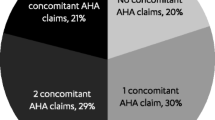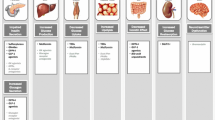Abstract
The treatment objective in diabetes is prevention of the onset or progression of complications. Intensive treatment reduces the risk of complications. The aim of the study was to evaluate glycemic control in patients with type 2 diabetes mellitus treated with metformin monotherapy at the maximal-tolerated dose. This retrospective, multicenter, observational study, enrolled patients ≥45-year old receiving metformin as monotherapy for at least 36 months. Data were collected on demographic and disease characteristics, clinical status, lifestyle, comorbidities, and diabetes complications at baseline, 9, 18, and 24 months. Primary study variables were percentage of patients achieving HbA1c <7 % and mean HbA1c reduction after 9 months. Eligible patients (n = 524, mean age 65.9 ± 7.9 years) had a mean age at diagnosis of 57.5 ± 7.9 years. A second antidiabetic drug was added in 24 % of patients (126/524); time to treatment escalation was 44.7 ± 25.1 months. Regarding primary study variables, 61.7 % of patients (322/522) achieved HbA1c of 7.0 % at 9 months, compared to 37.0 % of patients (194/524) at baseline; mean HbA1c was reduced from 7.30 ± 0.95 to 6.84 ± 0.86 % after 9 months. The estimated mean time of exposure above 7 % was 19 months, 15 months for patients ≥65-year old, and 21 months for younger patients. Regression analysis revealed that patients with longer disease duration, and patients <65-year old responded less well to metformin. A substantial number of patients continued to receive monotherapy instead of intensified therapy and were exposed to hyperglycemia.



Similar content being viewed by others
References
International Diabetes Federation. IDF Diabetes Atlas Sixth Edition, 2014 Update. http://www.idf.org/worlddiabetesday/toolkit/gp/facts-figures. Accessed March 5, 2015
J.S. Skyler, R. Bergenstal, R.O. Bonow, J. Buse, P. Deedwania, E.A. Gale, B.V. Howard, M.S. Kirkman, M. Kosiborod, P. Reaven, R.S. Sherwin, American Diabetes Association; American College of Cardiology Foundation; American Heart Association: intensive glycemic control and the prevention of cardiovascular events: implications of the ACCORD, ADVANCE, and VA diabetes trials: a position statement of the American Diabetes Association and a scientific statement of the American College of Cardiology Foundation and the American Heart Association. Diabetes Care 32, 187–192 (2009)
J.B. Brown, G.A. Nichols, A. Perry, The burden of treatment failure in type 2 diabetes. Diabetes Care 27, 1535–1540 (2004)
S.E. Inzucchi, R.M. Bergenstal, J.B. Buse, M. Diamant, E. Ferrannini, M. Nauck, A.L. Peters, A. Tsapas, R. Wender, D.R. Matthews, American Diabetes Association (ADA), European Association for the Study of Diabetes (EASD), Management of hyperglycemia in type 2 diabetes: a patient-centered approach: position statement of the American Diabetes Association (ADA) and the European Association for the Study of Diabetes (EASD). Diabetes Care 35, 1364–1379 (2012)
S. Bolen, L. Feldman, J. Vassy, L. Wilson, H.C. Yeh, S. Marinopoulos, C. Wiley, E. Selvin, R. Wilson, E.B. Bass, F.L. Brancati, Systematic review: comparative effectiveness and safety of oral medications for type 2 diabetes mellitus. Ann. Intern. Med. 147, b386–b399 (2007)
W.D. Strain, M. Blüher, P. Paldánius, Clinical inertia in individualising care for diabetes: is there time to do more in type 2 diabetes? Diabetes Ther. 5, 347–354 (2014)
S.E. Inzucchi, Oral antihyperglycemic therapy for type 2 diabetes: scientific review. JAMA 287, 360–372 (2002)
J.A. Hirst, A.J. Farmer, R. Ali, N.W. Roberts, R.J. Stevens, Quantifying the effect of metformin treatment and dose on glycemic control. Diabetes Care 35, 446–454 (2012)
K. Zhou, L. Donnelly, J. Yang, M. Li, H. Deshmukh, N. Van Zuydam, E. Ahlqvist, Wellcome Trust Case Control Consortium 2, C.C. Spencer, L. Groop, A.D. Morris, H.M. Colhoun, P.C. Sham, M.I. McCarthy, C.N. Palmer, E.R. Pearson, Heritability of variation in glycaemic response to metformin: a genome-wide complex trait analysis. Lancet Diabetes Endocrinol. 2, 481–487 (2014)
A.J. Garber, T.G. Duncan, A.M. Goodman, D.J. Mills, J.L. Rohlf, Efficacy of metformin in type II diabetes: results of a double-blind, placebo-controlled, dose-response trial. Am. J. Med. 103, 491–497 (1997)
A.A. Riedel, H. Heien, J. Wogen, C.A. Plauschinat, Loss of glycemic control in patients with type 2 diabetes mellitus who were receiving initial metformin, sulfonylurea, or thiazolidinedione monotherapy. Pharmacotherapy 27, 1102–1110 (2007)
A.J. Garber, D.S. Donovan Jr, P. Dandona, S. Bruce, J.S. Park, Efficacy of glyburide/metformin tablets compared with initial monotherapy in type 2 diabetes. J. Clin. Endocrinol. Metab. 88, 3598–3604 (2003)
L.A. Donnelly, A.S. Doney, A.T. Hattersley, A.D. Morris, E.R. Pearson, The effect of obesity on glycaemic response to metformin or sulphonylureas in Type 2 diabetes. Diabet. Med. 23, 128–133 (2006)
D.P. Martono, R. Lub, H.J. LambersHeerspink, E. Hak, B. Wilffert, P. Denig, Predictors of response in initial users of metformin and sulphonylurea derivatives: a systematic review. Diabetes Med. (2015). doi:10.1111/dme.12688
M.R. Taskinen, J. Borén, New insights into the pathophysiology of dyslipidemia in type 2 diabetes. Atherosclerosis. 239, 483–495 (2015)
C.B. Giorda, Could clinical inertia in part explain the unexpected association of insulin therapy with poorer cardiovascular outcomes in observational studies on diabetes? Diabetes Res. Clin. Pract. 92, e47–e48 (2011)
Author information
Authors and Affiliations
Consortia
Corresponding author
Ethics declarations
Informed consent
Informed consent was obtained from all individual participants included in the study.
Conflict of interest
This work was funded by an unrestricted grant by MSD Italia Srl. The sponsor had no role in selecting the participants, reviewing the literature, defining recommendations, drafting or reviewing the paper, or in the decision to submit the manuscript for publication. All views expressed are solely those of the authors. Medical writing assistance was provided by Editamed srl. The authors have no other conflict of interest to declare.
Appendix
Rights and permissions
About this article
Cite this article
Giorda, C.B., Cercone, S., Nada, E. et al. Results of the Adequacy of glycemiC Control in pAtients with type 2 Diabetes mEllitus treated with Metformin monotherapY at the maximal-tolerated dose (ACCADEMY) study. Endocrine 52, 507–515 (2016). https://doi.org/10.1007/s12020-015-0692-9
Received:
Accepted:
Published:
Issue Date:
DOI: https://doi.org/10.1007/s12020-015-0692-9




